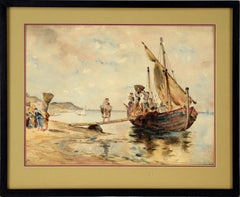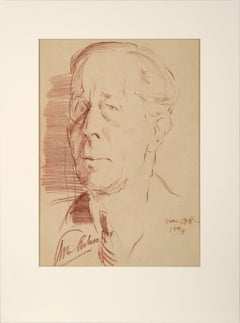Postcard Figurative Drawings and Watercolors
to
1
1
1
Overall Width
to
Overall Height
to
1
1
1
2
1
1
1
1
1
1
2
1
1
1
1
1
133
345
334
268
106
1
2
Style: Impressionist
Medium: Postcard
Loading the Cargo Ship - Brittany France - Watercolor 19th Century
Located in Soquel, CA
French Coastal Scene in Brittany with a merchant ship onloading fish and people by an unknown artist. A sailing vessel is anchored at a beach. A r...
Category
Late 19th Century Impressionist Postcard Figurative Drawings and Watercolors
Materials
Watercolor, Postcard, Illustration Board
$1,320 Sale Price
20% Off
Portrait of George Arliss in Conte Crayon on Cardstock 1934
Located in Soquel, CA
Stately portrait of George Arliss by Ivan Opffer (Danish, 1897-1980). Mr. Arliss is depicted wearing his signature monocle, looking directly at the viewer. Although this piece appears to be done rapidly, there is a clear confidence in Opffer's work - he was an accomplished portrait artist - and the resemblance to the subject is unmistakable. George Arliss (born Augustus George Andrews; 10 April 1868 – 5 February 1946) was an English actor, author, playwright, and filmmaker who found success in the United States. He was the first British actor to win an Academy Award – which he won for his performance as Victorian-era British prime minister Benjamin Disraeli in Disraeli (1929) – as well as the earliest-born actor to win the honour. He specialized in successful biopics, such as Disraeli, Voltaire (1933), and Cardinal Richelieu (1935), as well as light comedies, which included The Millionaire (1931) and A Successful Calamity (1932).
Signed and dated "Ivan Opffer 1934" in the lower right.
Titled "Mr. Arliss" in the lower left.
Presented in a new off-white mat with foamcore backing.
Mat size: 22"H x 16"W
Art size: 17.5"H x 12"W
Ivan Opffer (Danish, 1897-1980) was born in Nyborg, Denmark, on June 4, 1897, to a family of Danish scholars and journalists. His brother was Emil Opffer, a Danish merchant seaman and journalist who was known for his relationship with American writer Hart Crane.
Ivan was raised in Mexico City and New York, where his anarchist father was the editor of a radical Danish-language newspaper. His involvement in painting and drawing began at an early age. At a summer workshop, he met and studied drawing with Winslow Homer, then went on to study at the National Academy of Design and the Art Students League of New York.
When the US entered World War I, Opffer was one of the members of the American Army Camouflage Corps, headed by Homer Saint-Gaudens (whose mother was a relative of Winslow Homer), the son of Augustus Saint-Gaudens. As a camoufleur, Opffer served with other artists and architects, some of whom became well-known, including Barry Faulkner, Sherry Edmundson Fry, Kimon Nicolaides, Robert Lawson, Abraham Rattner, Kerr Eby, and others.
It was this same unit, while still in training in at Camp American University in Washington DC, that launched a camp newspaper called The Camoufleur. Only three issues were published before the unit’s deployment to France in late 1917. In the October 31 issue, a satirical portrait by Opffer of Homer Saint-Gaudens (titled “Our Boss”) was published on page 5.
After the war, Opffer returned to New York, where he became known for his caricatures of leading Modern writers, among them James Joyce, Edgar Lee Masters, Siegfried Sassoon, George Bernard Shaw, Carl Sandburg, G.K. Chesterton, and Thomas Mann.
In the years between the wars, Opffer married Betty à Beckett Chomley, and settled in Paris, where he was a student at the Academie Julliard. He also lived in London and Copenhagen, where his drawings were frequently published in newspapers and magazines. With the outbreak of World War II, he and his family returned to New York and lived in Greenwich Village.
Among his friends in that era were William Butler Yeats, F. Scott and Zelda Fitzgerald...
Category
1930s American Impressionist Postcard Figurative Drawings and Watercolors
Materials
Conté, Postcard, Illustration Board
Related Items
"Self Portrait Conte Sketch" rare Ben Fenske work on paper - academic study
By Ben Fenske
Located in Sag Harbor, NY
A colorful self-portrait from Ben Fenske, staring at the viewer straight-on. Hues of red dominate.
Unframed.
Ben Fenske (b. 1978) although a native of Minnesota, and has been worki...
Category
Early 2000s Academic Postcard Figurative Drawings and Watercolors
Materials
Paper, Conté
$1,200
H 25.5 in W 19 in
Untitled (Man Reclining on Tile Floor)
By Mark Beard
Located in New York, NY
Graphite and conté crayon on paper
Signed and dated, l.r.
This artwork is offered by ClampArt, located in New York City.
Mark Beard, born in 1956 in Salt Lake City, now lives in Ne...
Category
1970s Realist Postcard Figurative Drawings and Watercolors
Materials
Paper, Graphite, Conté
Self Portrait Sketch
By Ben Fenske
Located in Sag Harbor, NY
An early work on paper, by American Impressionist painter, Ben Fenske. It's rare to see a drawing like this from Fenske, especially of a self portrait. Fenske uses classical draftin...
Category
Early 2000s Academic Postcard Figurative Drawings and Watercolors
Materials
Paper, Conté
Sur la plage de Deauville - Impressionist Figurative Watercolor by Eugene Boudin
Located in Marlow, Buckinghamshire
Signed watercolour on paper landscape circa 1865 by French impressionist painter Eugene Boudin. This work depicts an artist painting a portrait of an elegant couple on the beach at D...
Category
1860s Impressionist Postcard Figurative Drawings and Watercolors
Materials
Paper, Watercolor
Pretty Woman in a Red & White Dress with Flowers in Her Bonnet (Impressionist)
By Lucius Rossi
Located in Rancho Santa Fe, CA
Lucius Rossi (1846-1913) was an Italian portrait and figurative painter who worked and lived in Paris. He was a friend and painter of many of the High Society people in Paris. A pain...
Category
Late 19th Century Impressionist Postcard Figurative Drawings and Watercolors
Materials
Watercolor, Laid Paper
$1,700
H 12.75 in W 8.75 in
Original Watercolour of Farmhouse in the Northern Ireland Countryside
Located in Preston, GB
Original Watercolour of Farmhouse in the Northern Ireland Countryside by 20th Century Irish Artist, D Hall
Art measures 8 x 6 inches
Frame measure...
Category
Late 20th Century Impressionist Postcard Figurative Drawings and Watercolors
Materials
Watercolor, Board, Archival Paper
$571 Sale Price
30% Off
H 15 in W 16 in D 1 in
The Loving Couple
By Charles Angrand
Located in Paris, Île-de-France
Circle of Charles Angrand (1854-1926)
The Loving Couple
Pencil and stump on paper,
30 x 22 cm
Dated "10.4.19" lower left. Trace of a dedication
Otherwise unsigned.
Provenance:
Pr...
Category
1910s Post-Impressionist Postcard Figurative Drawings and Watercolors
Materials
Conté, Carbon Pencil
Crinolones sur la Plage - Impressionist Figurative Watercolor by Eugene Boudin
Located in Marlow, Buckinghamshire
Signed and dated watercolour and pencil on paper by impressionist painter Eugene Boudin. The work depicts elegantly dressed people enjoying a day on the beach. Some women are resting...
Category
1860s Impressionist Postcard Figurative Drawings and Watercolors
Materials
Paper, Watercolor, Pencil
$25,167
H 14.5 in W 17.5 in
Young man in a toga elegant man Latin American hyperrealist Hockney style
Located in Norwich, GB
Superb original drawing in coloured conté pencils, heightened with white on oatmeal coloured vergé paper by Claudio Bravo. The work was created during the artist's Moroccan period, a...
Category
1970s Modern Postcard Figurative Drawings and Watercolors
Materials
Conté, Laid Paper, Color Pencil
$7,500
H 30.32 in W 24.02 in D 0.4 in
Portrait Sketch
By Ben Fenske
Located in Sag Harbor, NY
A portrait of a male head, in profile by BenFenske. The artist uses a variety of colors to convey a naturalist impression.
Artist Bio
Ben Fenske (b. 1978) although a native of Minn...
Category
21st Century and Contemporary Academic Postcard Figurative Drawings and Watercolors
Materials
Paper, Conté, Crayon
"Packed With Personality" (2024) by Mo Myra, Original Watercolor Painting
Located in Denver, CO
"Packed With Personality" (2024) by Mo Myra is a watercolor painting on paper that depicts a chicken standing in a grassy field.
Mo Myra, born in 1990, is a Connecticut-based artist...
Category
2010s Impressionist Postcard Figurative Drawings and Watercolors
Materials
Paper, Watercolor
$1,200
H 10 in W 8 in D 1.25 in
View of Dunoon on the Clyde
Located in Hillsborough, NC
Scottish artist Robert Carrick (1829-1904) is renowned for his landscape and figurative paintings in oil and watercolor. This painting features detailed drawings of figures in the foreground with wagon, and the town and scenery in the background, painted over in watercolor in rich raw umber and red-brown tones in the foreground and blue green tones in the background.
Carrick showed promise at a young age, exhibiting his work at the Royal Academy age 16. He was a member of the Royal Institute. This two-toned watercolor work has detailed figures, wagon with hay in the forefront above a view of Dunoon town near Glasgow as it was long ago. Signed by the artist, lower left with an inscription that reads: 'View of Dunoon, Argyllshire drawn by Robert Carrick, Glasgow, for David Allan'. Verso includes a copy of the same inscription.
Saltire Gallerie replaced the cracked and dirty plain glass with art glass and added an acid-free paper behind the work. While doing this work we found an art giclee, included with the painting.
Presented in a patterned wooden frame with art glass. Dunoon was a thriving town on the river at the time of this work, and later became part of Glasgow. The view from above the town is a popular one, as Saltire Gallerie has another view of Dunoon from above by Scottish artist Patrick Downie...
Category
19th Century Impressionist Postcard Figurative Drawings and Watercolors
Materials
Watercolor, Board, Pencil
$1,253 Sale Price
30% Off
H 14 in W 20.75 in D 1 in
Postcard figurative drawings and watercolors for sale on 1stDibs.
Find a wide variety of authentic Postcard figurative drawings and watercolors available on 1stDibs. While artists have worked in this medium across a range of time periods, art made with this material during the 20th Century is especially popular. There are many well-known artists whose body of work includes ceramic sculptures. Popular artists on 1stDibs associated with pieces like this include and Jean-Michel Folon. Frequently made by artists working in the Impressionist, Surrealist, all of these pieces for sale are unique and many will draw the attention of guests in your home. Not every interior allows for large Postcard figurative drawings and watercolors, so small editions measuring 0.1 inches across are also available Prices for figurative drawings and watercolors made by famous or emerging artists can differ depending on medium, time period and other attributes. On 1stDibs, the price for these items starts at $11 and tops out at $1,595,000, while the average work can sell for $701.
Recently Viewed
View AllMore Ways To Browse
Carol Young Barn
Cavalier Dog Painting
Charles Bronson
Charles Culver Paintings
Clair De Lune Paintings
Constantinople Landscape Painting
David Weeks Chandelier
E Fletcher
Elizabeth Chalmers
Elizabeth Wilcox
Fat Lady Vintage
Frank Heath
Frederick Richard Lee
Henry Rogers
Sandy Hook Painting
Stuyvesant Van Veen
Summer J Hart
Terriers Ratting Painting


